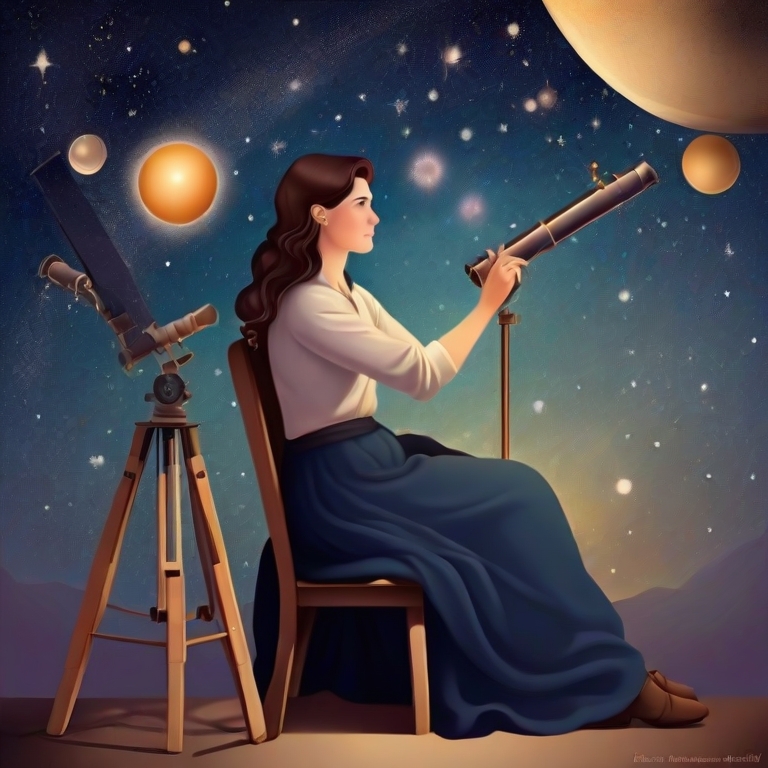
Introduction
The stars have always been a source of wonder and fascination for humanity, but for centuries, the field of astronomy was dominated by men. However, behind the scenes, women were making significant contributions to our understanding of the universe, often facing immense obstacles and overcoming incredible odds. Today, we celebrate the trailblazing achievements of these female pioneers on National Woman Astronomers Day. This special day is a chance to recognize the groundbreaking work of women who have expanded our knowledge of the cosmos, paved the way for future generations, and inspired countless others to reach for the stars.
1. Ancient Pioneers: The Forgotten Women of Ancient Astronomy
The pursuit of understanding the universe has been a centuries-long journey, with women playing a crucial role in its development. Ancient civilizations recognized the importance of astronomy, and female astronomers made significant contributions despite facing societal restrictions.
• Babylonian priestesses tracked planetary movements, while the ancient Greek philosopher Hypatia of Alexandria wrote extensively on astronomy and mathematics.
• These women pioneers defied convention, pushing the boundaries of human knowledge with their passion for discovery and understanding the universe’s mysteries.
• Their stories, though fragmented and obscured by time, offer a fascinating glimpse into the lives of women who challenged the status quo and pursued their passion for astronomy.
• The pursuit of knowledge and understanding is a universal human endeavor, transcending time and culture.
• The contributions of ancient women astronomers have often been overlooked, but their stories remind us of the importance of recognizing and celebrating their achievements.
• By exploring the stories of these ancient pioneers, we can gain a deeper appreciation for the role women have played in shaping our understanding of the universe.
2. Maria Mitchell: The First Woman of American Astronomy
Maria Mitchell, a 19th-century astronomer, made significant contributions to the field of astronomy. Born in Nantucket, Massachusetts, in 1818, Mitchell’s interest in astronomy began at a young age, encouraged by her father, an amateur astronomer. Despite being a woman in a male-dominated field, Mitchell’s determination and perseverance paved the way for future generations of female astronomers.
• In 1847, Mitchell discovered a comet, later known as “Miss Mitchell’s Comet,” earning her international recognition and a gold medal from the King of Denmark.
• This achievement solidified her position as a respected astronomer and inspired a new wave of women to pursue careers in science.
• Mitchell’s remarkable life was marked by numerous firsts, including:
1 Being the first woman elected to the American Academy of Arts and Sciences
2. Being the first woman to work as a professor of astronomy at Vassar College
• Mitchell’s legacy extends beyond her impressive accomplishments, inspiring women to challenge the status quo and push the boundaries of what is possible.
• She continues to inspire women to pursue careers in science, leaving an indelible mark on the field of astronomy.
3. Caroline Herschel: The First Woman to Discover a Comet
Caroline Herschel, a pioneering astronomer, defied convention and made a lasting impact in the field of astronomy. Born in 1750 in Hanover, Germany, Caroline’s passion for the stars drove her to succeed in a male-dominated field. She began her career as an assistant to her brother, William Herschel, a renowned astronomer. Together, they formed a formidable team, with Caroline recording observations, making calculations, and discovering new nebulae.
• Caroline’s solo discovery of a comet in 1786 marked a significant milestone in her career, earning her recognition from the Royal Society.
• She became the first woman to receive a salary as an astronomer from the British monarch, a testament to her groundbreaking achievement.
Caroline’s remarkable journey paved the way for future generations of women in astronomy, inspiring them to challenge the boundaries of what was thought possible. Her determination and passion for the stars left an indelible mark on the field of astronomy, cementing her status as a trailblazing woman in history.
4. Henrietta Leavitt: Measuring the Universe
Henrietta Leavitt, a brilliant astronomer, revolutionized our understanding of the universe in the early 20th century. While working at the Harvard College Observatory, she analyzed photographic plates of celestial objects, leading to a groundbreaking discovery. Leavitt found that the brightness of a star is directly related to its distance from Earth, establishing the “period-luminosity relationship.” This concept enabled astronomers to calculate vast distances between stars and galaxies, effectively mapping the universe on a previously unimaginable scale.
Leavitt’s work laid the foundation for Edwin Hubble’s later discovery of the expanding universe. Her legacy continues to inspire generations of astronomers and scientists. Despite facing obstacles and biases in a male-dominated field, Leavitt’s pioneering spirit and dedication to her craft have left a lasting impact on astronomy.
Key points:
• Henrietta Leavitt’s work at the Harvard College Observatory led to a groundbreaking discovery in astronomy.
• She established the “period-luminosity relationship,” which relates a star’s brightness to its distance from Earth.
• This concept enabled astronomers to calculate vast distances between stars and galaxies, mapping the universe on a previously unimaginable scale.
• Leavitt’s work laid the foundation for Edwin Hubble’s discovery of the expanding universe.
• Despite facing obstacles, Leavitt’s legacy continues to inspire generations of astronomers and scientists.
5. Cecilia Payne-Gaposchkin: The First Woman to Head a Harvard Department
Cecilia Payne-Gaposchkin, a British-American astrophysicist, made a lasting impact on astronomy, breaking barriers and advancing human understanding. Born in 1900, her curiosity about the universe began at a young age, leading her to defy conventions and become the first woman to head a department at Harvard University.
Key highlights of her career include:
• Her groundbreaking Ph.D. thesis proposes that stars are primarily composed of hydrogen and helium, a revolutionary concept at the time.
• Her research laid the foundation for modern astrophysics, with her findings later confirmed by other astronomers.
• Her pioneering work in the composition of stars pushes the boundaries of human understanding.
Cecilia’s achievements are remarkable, given the era’s prevailing sexism and bias against women in science. Her legacy continues to inspire generations of women to pursue careers in STEM fields. Today, her contributions to astronomy are still celebrated, cementing her place as a trailblazing figure in the field.
6. The Modern Era: Women Who Continue to Shape Astronomy
The field of astronomy is experiencing a transformative era, marked by a significant increase in talented women who are driving innovation and pushing the boundaries of human understanding. Women like Dr. Sandra Kortner, Dr. Jocelyn Bell Burnell, Dr. Natalie Batalha, and Dr. Lisa Kaltenegger are making groundbreaking contributions to the field, from discovering the Higgs boson particle to detecting pulsars and redefining the frontiers of astronomical knowledge.
These women are not only exceptional scientists but also passionate advocates for diversity, equity, and inclusion. They are challenging stereotypes, dismantling biases, and creating a more inclusive and diverse astronomy community that reflects the richness of human experience.
Key highlights of their contributions include:
• Breaking barriers and shattering glass ceilings in astronomy
• Driving innovation and pushing the boundaries of human understanding
• Making groundbreaking discoveries and redefining the frontiers of astronomical knowledge
• Advocating for diversity, equity, and inclusion in the field
• Creating a more inclusive and diverse astronomy community
The pursuit of astronomical knowledge is a collective endeavor, and the contributions of women are essential to advancing our understanding of the universe. As we celebrate their achievements, we are reminded of the importance of diversity and inclusion in driving progress and innovation in astronomy.
7. Sally Ride: The First American Woman in Space
Sally Ride made history on June 18, 1983, as the first American woman to venture into space aboard the space shuttle Challenger on mission STS-7. This achievement not only solidified her place in astronomy but also inspired a generation of women to pursue careers in STEM fields.
Ride’s journey began with a Ph.D. in physics from Stanford University, where she was recruited by NASA in 1978 as part of the first group of women astronauts. Her scientific expertise and physical fitness made her an ideal candidate for space travel.
As a mission specialist, Ride played a crucial role in deploying two communications satellites and conducting experiments on the space shuttle’s robotic arm. Her achievement extends beyond her own accomplishments, serving as a beacon of hope for women and girls everywhere, proving that they too can succeed in a traditionally male-dominated field.
Ride’s legacy continues to inspire and motivate, demonstrating the power of determination and hard work in breaking down barriers and pushing the boundaries of human exploration. Key points of her achievement include:
• First American woman in space
• Inspired a generation of women in STEM fields
• Deployed two communications satellites and conducted experiments on the space shuttle’s robotic arm
• Became a beacon of hope for women and girls everywhere
• Legacy continues to inspire and motivate, demonstrating the power of determination and hard work
8. The Challenges Women in Astronomy Still Face Today
Despite the progress made by women in astronomy, the field still faces significant barriers to women’s participation and advancement. Gender bias, both subtle and overt, remains a major obstacle, leading to women being underestimated and overlooked for opportunities. Additionally, women in astronomy often bear a disproportionate burden of caregiving responsibilities, making it difficult to balance work and family life and leading to a lack of representation in senior positions.
Women from underrepresented groups face even more significant challenges, including systemic racism, socioeconomic barriers, and limited access to resources and opportunities. The culture of astronomy, which emphasizes individual achievement and competition, can be intimidating and unwelcoming to women, leading to feelings of isolation and burnout.
To create a more inclusive and equitable environment, it is essential to address these challenges and work towards creating a culture that values diversity, collaboration, and support. Key challenges to be addressed include:
• Persistent gender bias and discrimination
• Disproportionate caregiving responsibilities
• Lack of representation in senior positions
• Systemic racism and socioeconomic barriers
• Limited access to resources and opportunities
• Intimidating and unwelcoming culture
By acknowledging and addressing these challenges, we can create a more inclusive environment that allows women in astronomy to thrive and reach their full potential.
9. Celebrating the Next Generation of Female Astronomers
The next generation of female astronomers is building upon the foundation laid by their predecessors, pushing the boundaries of our understanding of the universe, and making groundbreaking discoveries. These women are:
• Investigating the mysteries of black holes
• Exploring the possibilities of extraterrestrial life
• Advocating for greater diversity and inclusion in the field
• Mentoring students, speaking at conferences, and engaging in public outreach
• Inspiring a new wave of young women to pursue careers in astronomy
Their dedication to the field is a testament to the power of perseverance and the impact that women can have when given the opportunity to shine. As we celebrate the pioneering women of astronomy, it’s essential to recognize and support the next generation of female astronomers who are reaching for the stars and beyond.
10. The Legacy of Women in Astronomy
The contributions of women in astronomy have been instrumental in expanding our understanding of the universe. From ancient Greece to modern-day space exploration, women have played a vital role in pushing the boundaries of human knowledge. Despite often being overlooked, their stories are a testament to determination, resilience, and passion.
• These pioneering women have defied convention, challenged stereotypes, and paved the way for future generations of women in astronomy.
• Their legacy serves as a beacon of inspiration, illuminating the path for girls and women around the world who are curious about the universe.
• As we celebrate their achievements, we are reminded of the work still to be done to ensure equal opportunities for women in astronomy and other STEM fields.
• The universe holds endless possibilities, and women in astronomy are leading the way.
• By honoring the women who have come before us, we look forward to the many discoveries that will be made by the women who will come after us.
Conclusion
As we conclude this celebration of National Woman Astronomers Day, we’re reminded of the incredible impact that women have had on the field of astronomy. As we look to the future, we’re excited to see the continued contributions of women in astronomy and to inspire a new generation of female astronomers to join the ranks of these stellar pioneers. Here’s to the women who have changed the face of astronomy, and to the many more who will continue to shape its future.
National Woman Astronomers Day FAQs
Q1: Who is the first woman astronomer?
Hypatia of Alexandria (c. 350-415 CE) is considered one of the first female astronomers. She was a Greek mathematician, astronomer, and philosopher.
Q2: What is the percentage of women in astronomy?
According to the American Astronomical Society, women make up about 25% of astronomers in the United States.
Q3: What are some organizations that support women in astronomy?
Organizations like the Astronomical Society of the Pacific, the International Astronomical Union, and the American Astronomical Society have initiatives to support and promote women in astronomy.
Q4: Can anyone become an astronomer?
Yes, anyone with a passion for astronomy and a strong foundation in math and science can pursue a career in astronomy.

